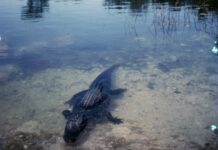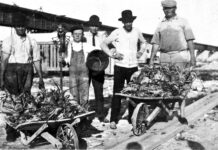A land-based highway mile, known as a statute mile, measures 5,280 feet. Water-based miles, called nautical miles, are a little bit longer and measure 6,076 feet, making the distance between Key West and Havana, Cuba, 105 statute miles. Based on the nautical mile, the distance is 91.24 miles.
On Nov. 7, 1822, the U.S. schooner Alligator sailed from Havana to Matanzas, about 50 statute miles east. The schooner sailed into the harbor at Matanzas on Nov. 8. No sooner had she dropped her anchor than Freeman Mayo, the master of the schooner Iris, boarded the vessel. He informed the captain of the Alligator, Lt. William H. Allen, that his ship and crew were being held for ransom. If he did not deliver $6,000 ($7,000 in some accounts) to the pirates the following day, his crew would be killed, and his ship burned.
Without hesitation, Lt. Allen committed the Alligator and its crew to the liberation of the Iris and whatever other vessels were being held. The Alligator left Matanzas and set a course for “Point Hycacos” to the east. At daylight, the Alligator dropped anchor off one of the islands near the entrance to Bahia de Cardenas. From their vantage point, they could see three vessels at anchor farther up the bay. A small schooner with its decks filled with men was sailing nearby.
Unable to navigate the bay’s shallows, the Alligator’s auxiliary ships were employed: a launch, cutter and a gig. Allen took command of the launch. Lt. Dale, his second in command, took control of the cutter, and a midshipman and four other crew members boarded the gig. The men, using oars, began to paddle toward the ships.
One of the schooners at anchor was the pirate ship Revenge, armed with five cannons and a copper-colored hull. Because the wind was light, the men of the Revenge manned the ship’s oars and attempted to paddle the schooner deeper into the bay and away from Allen and the approaching marines. After rowing for two hours, a reported 3-4 leagues (11-12 miles), the Americans gained within striking distance of the schooner.
Thirty armed cutthroats manned the Revenge’s deck. The pirates hoisted a red flag. They fired a broadside of round and grapeshot, but the pirates’ aim proved wild, and none of the Alligator’s auxiliary ships suffered significant damage. On the contrary, as the marines drew closer, accurate musket fire began to cripple the pirate attack.
When a second pirate schooner appeared, the men of the Revenge abandoned their oars and worked to escape the schooner on long boats. Before they did, however, they took several bottles filled with gunpowder, inserted slow-burning wicks through their corks, and lit them on fire. They planned to have the marines board the Revenge and take her for their prize, only to blow it up and take their lives.
As the pirates attempted to escape to the other pirate schooner, Allen and Dale maneuvered their vessels, cut the pirates off, and forced them back to their schooner. They quickly extinguished the slow-burning fuses. As gunfire echoed across the water, the marines advanced on the Revenge, causing the pirates to abandon her again. Securing the prize, Allen directed the midshipman and his crew of four to board the Revenge. Allen and Dale continued to chase down the pirates as they made their way to the second schooner. Her decks were crowded with 60 to 80 men armed with muskets, cutlasses and pikes. They opened fire on the marines.
Allen was struck in the head but continued to shout orders and support when he was struck a second time in the chest. He was not the only one shot in the pirate fight. The marines abandoned their chase and returned to collect their prize and the merchant ships that pirate forces had held. The pirates escaped.
Four hours later, Allen succumbed to his wounds and was one of four marines killed during the skirmish; three others were wounded. Allen’s dying wish was that the government would take care of his mother and sister. On Nov. 11, at Matanzas, Cuba’s lieutenant governor attended a ceremony for Allen, where he and the other marines were interred with military honors. They would learn that 14 pirates had been killed in the fight, including one of the horde’s captains.
Dale, Allen’s second in command, was the captain in charge of the Alligator when, at about 5 a.m. on Nov. 18, 1822, its sails were hoisted, and the schooner began the slow move away from Matanzas, Cuba, on the final mission of the ship’s brief but storied career.
There would be one more casualty among the Alligator’s crew.
All would survive when the ship wrecked against the Matecumbe Reef at about 9:30 p.m. the following day. Three days after wrecking on the reef, the crew of the Alligator was rescued by the Ann Maria, one of the ships it had saved during the pirate fight. Sadly, while sailing between the Matecumbe Reef and Charleston, South Carolina, the Alligator’s cook, Hector Williams, fell overboard and was pronounced lost at sea.
Today, the Alligator wreck site is recognized as Alligator Reef and is home to the second tallest of the lights marking the Florida Reef, Alligator Reef Lighthouse.


























